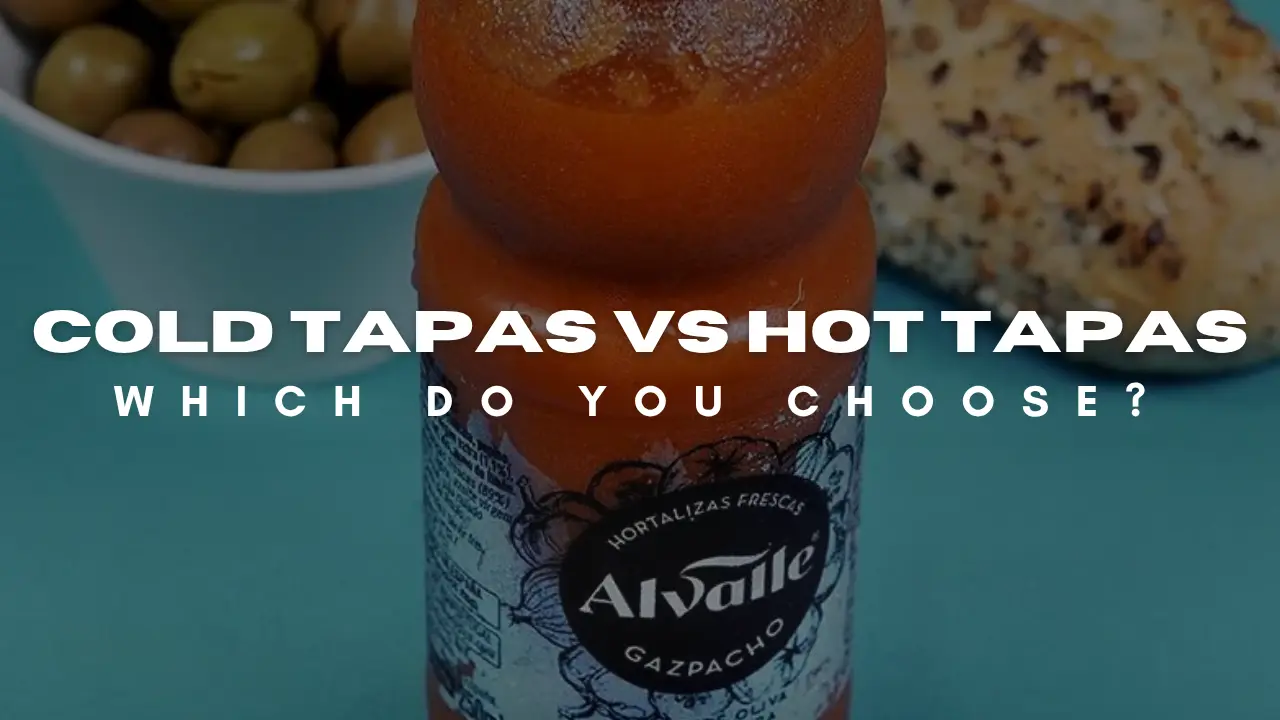At Gastronomic Spain, we know that in summer, you feel like eating light, tasty, and without complications. That’s why, in this article, we will compare cold tapas vs hot tapas, highlighting quick and easy options versus more elaborate dishes. You’ll see that, although both have their charm, there are very practical reasons to prefer one or the other depending on the occasion.
1. What do we mean by cold tapas for summer?
Cold tapas for summer are those preparations that are served cold or at room temperature, ideal for beating the heat and enjoying without turning on the stove. They’re perfect for outdoor dinners, light meals after a long day, or improvised gatherings.
1.1 Gazpacho: the queen of cold tapas for summer
Ingredients: tomato, pepper, cucumber, garlic, olive oil. All blended and chilled.
Time: less than 5 minutes to prepare (not counting refrigeration).
Nutritional value: vitamins, hydration, and freshness.
Why does it fit into cold tapas for summer and quick and easy? Because it’s a super simple and refreshing classic you can have ready in minutes.
1.2 Salmorejo: a denser and creamier version
Ingredients: tomatoes, bread, garlic, oil, vinegar. A thicker texture.
Time: around 5 minutes of cleaning and blending.
Ideally served with chopped hard-boiled egg and serrano ham.
Another example of cold tapas for summer that is also quick and easy and satisfying without being greasy.
1.3 Other simple and fresh options
Avocado and tuna salad: chop, mix, and season in under 5 minutes.
Tomato toast with oil and garlic (toasted bread, grated tomato, garlic, oil).
These options also fall into the cold tapas for summer category and are very quick and easy to prepare.
In short: Cold tapas for summer are light, nutritious, and perfect for informal dinners—and their simplicity makes them very quick and easy to prepare.
2. Traditional hot tapas: spoon-worthy flavors
When temperatures drop or you’re craving a bolder flavor, traditional hot tapas, such as spoon dishes, take the lead. They’re more elaborate, require more time, and offer intense textures and flavor layers. We’ll give you some practical tips to help you choose between cold and hot tapas.
2.1 Pork ear in sauce
Traditionally a main course, now a tapa in many bars.
It involves slow cooking in sauce (wine, spices), although you can buy it already cooked and just heat it.
Perfect for fans of traditional hot tapas: strong flavor, gelatinous texture, and very tasty.
Time: if using pre-cooked food, about 10–15 minutes; from scratch, several hours.
2.2 Oxtail in sauce
A classic of Spanish cuisine: oxtail slow-cooked, deboned and rich, with vegetables and wine.
A traditional tapa or stew that embodies traditional hot tapas: robust, tasty, and full-bodied.
Time: at least 2–3 hours of cooking, though you can take it from the fridge and reheat in 10 minutes if already prepared.
2.3 Faster homemade options served warm
-
Small pre-cooked tripe: buy ready-made, heat for 10 minutes.
-
Chickpeas with chorizo in a mild sauce: use cooked chickpeas, light sauté, and chorizo chunks.
Though less common as tapas, they are still part of the traditional hot tapas, and their quick version can take about 15–20 minutes.
These tapas offer intense flavors, texture, and tradition, though they don’t fall into the “quick and easy” category if made from scratch. But combined with pre-cooked options, they can be served in a reasonable amount of time.
3. Detailed comparison: Cold tapas vs hot tapas
| Feature | Cold tapas for summer | Traditional hot tapas |
|---|---|---|
| Preparation time | < 5 minutes (gazpacho, salmorejo) | 10 min (pre-cooked) to several hours (from scratch) |
| Freshness / temperature | Cold or room temp, very refreshing | Hot, dense, heavier |
| Nutritional value | Vitamins, water, low fat | Energy, protein; more fat |
| Ease in the kitchen | Very simple: mix and blend | Require slow cooking or reheating |
| Ideal for… | Hot afternoons, light dinners, picnics | Winter, formal gatherings, flavor lovers |
4. Recommendations by situation
If you’re looking for efficiency and freshness in summer:
Choose cold tapas for summer, like gazpacho, salmorejo, or a simple salad. They are quick and easy to prepare and promote hydration and lightness.
If you’re craving traditional, hearty flavor:
Go for traditional hot tapas like pork ear in sauce or oxtail. Ideal for slower meals, friends who enjoy intense flavors, or autumn/winter dinners.
Whether you choose cold tapas or hot tapas, this cold tapas vs hot tapas guide helps you understand that it all depends on your personal tastes and cravings.
5. What’s the ideal combination for this summer?
You can combine both styles: a cold tapa (gazpacho or salmorejo) as a starter and the hot tapa as a light main course. This way, you integrate the best of both worlds.
When the thermometer rises, there’s nothing better than cold tapas for summer. Why? Because they combine freshness, nutrition, and flavor in quick and easy preparations like gazpacho or salmorejo. In under five minutes, you can have a cold, refreshing dish that hydrates and provides vitamins. These options are perfect if you want something light, healthy, and hassle-free. That’s why we talk about cold tapas for summer that are also quick and easy: just chop, blend, and season.
Pork ear in sauce or oxtail—they’re the classic traditional hot tapas, perfect when you want a strong and comforting bite. These traditional hot tapas require more time (or buy ready-made and reheat), but they reward you with flavor, texture, and table presence. If you’re in a hurry, you could opt for pre-cooked versions and have them ready in half an hour.
